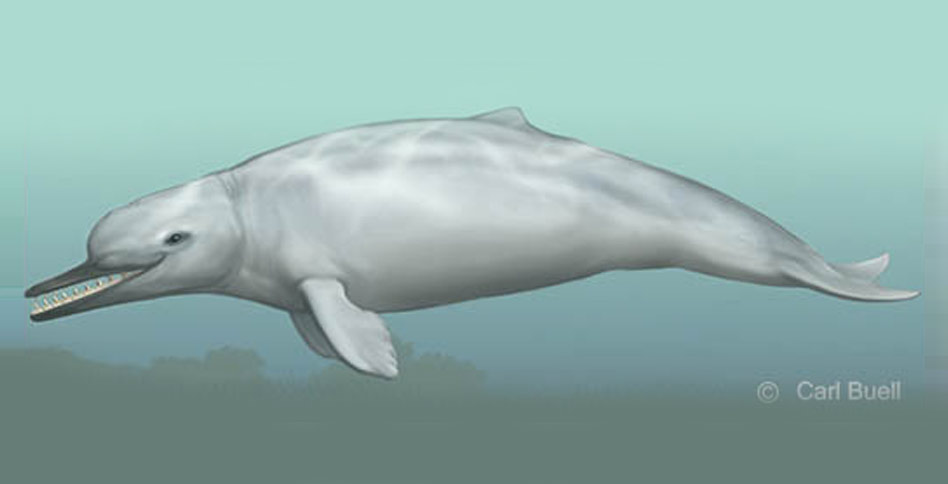
Cotylocara macei
Age: 28 million years old, Oligocene Epoch.
Range: The only known specimen of Cotylocara macei was found in the vicinity of present-day Charleston, South Carolina.
Size: The skeleton is largely unknown for Cotylocara macei; however, the length of its body can be estimated from the size of its skull. Living cetaceans with a similarly sized skull are about 10 to 11 feet in length.
Anatomy: Two aspects of the skull of Cotylocara are surprising: its asymmetry and degree of telescoping. In the skulls of all living odontocete, bones that are restricted to the rostrum of other mammals have spread out over the bones of the braincase. The term used for this evolutionary process is “telescoping” and is derived from the collapsible, nautical telescopes; just as the nested cylinders of a telescope slide past each other, the bones of odontocete skulls have slid past each other through evolution. Cotylocara has by far the most telescoped skull of any Oligocene odontocete (those living between 24-35 million years ago), and in fact its degree of telescoping is on par with that of many living species.
Even more surprising is that Cotylocara belongs to an extinct family, the Xenorophidae, that also includes species with relatively untelescoped skulls. Thus the highly telescoped skull of Cotylocara evolved convergently and separately from those of living odontocetes. Features shared by Cotylocara and other xenorophids are: excavation on the rostrum for an air sinus; transverse and backward expansion of the premaxillae (the front tooth-bearing bones of the skull) over the orbits; expansion of the lacrimal, a bone that typically forms the front wall of the orbit, over the orbit; and a prong of bone that firmly attaches the inner ear bone to the rest of the skull.
The skull of Cotyolocara is distinctly asymmetric, and it is the most asymmetric of any Oligocene odontocete. Asymmetry occurs in several places of the skull including: the entire face is twisted counterclockwise when viewed head-on, the right and left air sinus basins on the rostrum are very different sizes, and sutures between paired bones on the skull are shifted towards the left side, instead of being centered. All living cetaceans have asymmetric faces, and in most cases the asymmetry is also reflected in the skull. The functional significance of the asymmetry is unclear; some have suggested it may be involved in the production of complex vocalizations for echolocation, others think that it may lead to improved hearing for echolocation, and one study suggested that it may allow for larger prey to be swallowed whole. The significance of the pronounced asymmetry in Cotylocara is unknown.
Locomotion: The forelimbs and tail of Cotylocara have not been found, so there is little direct evidence for how it moved through the water. That said, there is ample evidence to suggest that by this time all cetaceans had a tail fluke, flippers for forelimbs, and vestigial hindlimbs that likely ended in the body wall.
Sensory Abilities: The discovery of Cotylocara macei has important implications for the evolution of echolocation. All living odontocetes echolocate; whereby they produce high-frequency vocalizations and then use delays in hearing the echoes to build an acoustic image of their environment. Their vocalizations are produced in the face at the phonic lips, not the larynx as is typical of other mammals. The phonic lips are a constriction in the nasal passage between the blowhole and the skull, and sounds are produced as air rushes past this constriction, much like letting air out of a balloon. The use of high-frequency sound allows for small objects to be detected, thus odontocetes can use echolocation to find prey.
Several features indicate that Cotylocara could echolocate. The cavities at the base of the rostrum and the top of the skull were likely formed by air sinuses. In living odontocetes these air sinuses are thought to have two important functions in echolocation: 1) they are situated on either side of the phonic lips and allow air to be continuously cycled past the phonic lips, allowing for uninterrupted vocalizations, 2) they redirect sound waves traveling backward, thus amplifying a forward–projecting beam of sound. The air sacs reflect sound waves because of the great density difference between air and tissue (for a similar reason, a person underwater hears little of the sounds traveling in the air above). High-density bone can also reflect sound, and the rostrum of Cotylocara is quite dense. Finally the maxilla (the main tooth-bearing bone of the skull) is exceptionally large and spread out over the braincase. This bone serves as an anchor for the large and complex muscles that control the sound-producing apparatus in the face of living odontocetes. Thus by inference, Cotylocara had large facial muscles that functioned in echolocation. If Cotylocara macei echolocated, as the evidence suggests, then it appears that this behavior evolved between 35 and 32 million years ago. After it evolved, the skull of Cotylocara and those of other fossil odontocetes suggest that the air sinuses and the facial muscles enlarged and odontocetes evolved a more sophisticated form of echolocation.
Diet: Cotylocara likely ate fish, as is the case for many living odontocetes. Its long and narrow snout, tall interlocking teeth, and worn tooth cusps suggest that it grabbed prey with its front teeth before swallowing prey whole. Some living odontocetes capture prey with suction-feeding; where they suck prey and water into the mouth.
This feeding strategy works best if the snout is relatively short and mouth wide, such as seen in a beluga. It is unlikely that Cotylocara used suction feeding given its long and narrow rostrum.
Author: Jonathan Geisler
References Consulted: Geisler, J. H., Colbert, M. W., and Carew, J. L. 2014. A new fossil species supports an early origin for toothed whale echolocation. Nature. doi:10.1038/nature13086. Published online March 12.